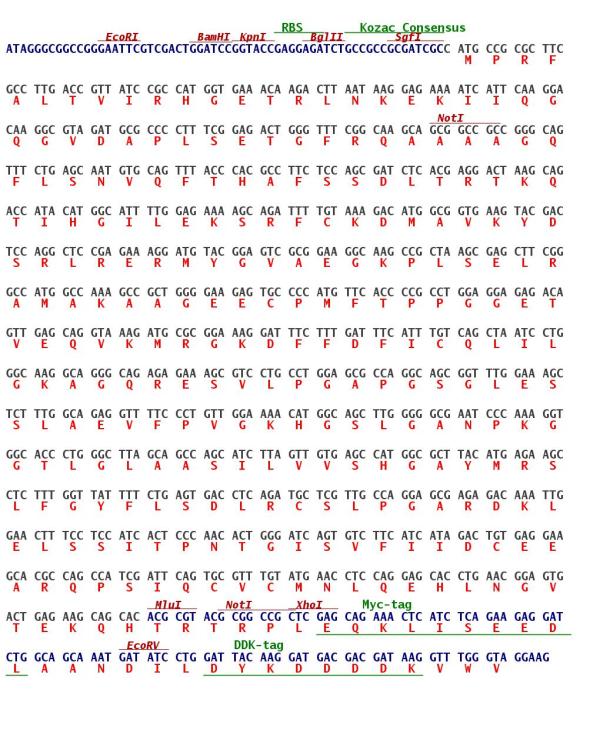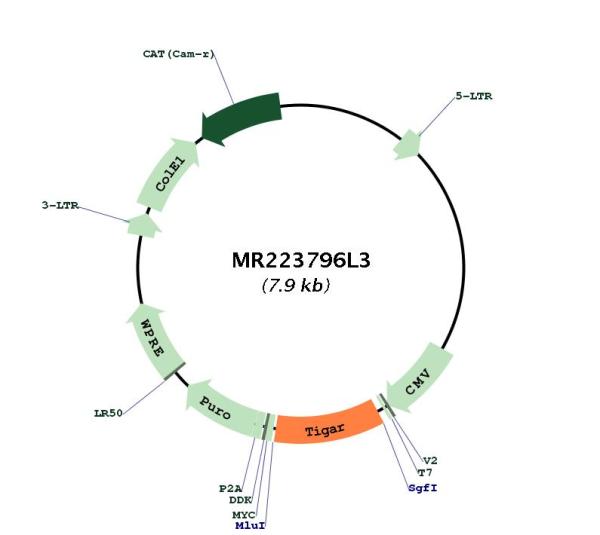Tigar (NM_177003) Mouse Tagged Lenti ORF Clone
SKU
MR223796L3
Lenti ORF clone of 9630033F20Rik (Myc-DDK-tagged) - Mouse RIKEN cDNA 9630033F20 gene (9630033F20Rik)
-
LentiORF®
LentiORF®
Expression-ready ORF plasmid in lenti backbone
Click here to learn more.
| Product Data | |
| Type | Mouse Tagged ORF Clone |
|---|---|
| Target Symbol | Tigar |
| Synonyms | 9630033F20Rik; AA793651; AI595337; C79710; C85509 |
| Vector | pLenti-C-Myc-DDK-P2A-Puro |
| E. coli Selection | Chl (34 ug/mL) |
| Mammalian Cell Selection | Puromycin |
| Sequence Data |
ORF Nucleotide Sequence
The ORF insert of this clone is exactly the same as(MR223796).
|
| Restriction Sites |
SgfI-MluI Cloning Scheme for this gene
Plasmid Map

|
| ACCN | NM_177003 |
| ORF Size | 807 bp |
| OTI Disclaimer | The molecular sequence of this clone aligns with the gene accession number as a point of reference only. However, individual transcript sequences of the same gene can differ through naturally occurring variations (e.g. polymorphisms), each with its own valid existence. This clone is substantially in agreement with the reference, but a complete review of all prevailing variants is recommended prior to use. More info |
| OTI Annotation | This clone was engineered to express the complete ORF with an expression tag. Expression varies depending on the nature of the gene. |
| Components | The ORF clone is ion-exchange column purified and shipped in a 2D barcoded Matrix tube containing 10ug of transfection-ready, dried plasmid DNA (reconstitute with 100 ul of water). |
| Reconstitution Method | 1. Centrifuge at 5,000xg for 5min. 2. Carefully open the tube and add 100ul of sterile water to dissolve the DNA. 3. Close the tube and incubate for 10 minutes at room temperature. 4. Briefly vortex the tube and then do a quick spin (less than 5000xg) to concentrate the liquid at the bottom. 5. Store the suspended plasmid at -20°C. The DNA is stable for at least one year from date of shipping when stored at -20°C. |
| Note | Plasmids are not sterile. For experiments where strict sterility is required, filtration with 0.22um filter is required. |
| Shipping | Ambient |
| Reference Data | |
| RefSeq | NM_177003.5, NP_795977.1 |
| RefSeq Size | 3653 bp |
| RefSeq ORF | 810 bp |
| Locus ID | 319801 |
| UniProt ID | Q8BZA9 |
| Cytogenetics | 6 F3 |
| Summary | Fructose-bisphosphatase hydrolyzing fructose-2,6-bisphosphate as well as fructose-1,6-bisphosphate (By similarity). Acts as a negative regulator of glycolysis by lowering intracellular levels of fructose-2,6-bisphosphate in a p53/TP53-dependent manner, resulting in the pentose phosphate pathway (PPP) activation and NADPH production (PubMed:23726973). Contributes to the generation of reduced glutathione to cause a decrease in intracellular reactive oxygen species (ROS) content, correlating with its ability to protect cells from oxidative or metabolic stress-induced cell death (PubMed:23726973). Plays a role in promoting protection against cell death during hypoxia by decreasing mitochondria ROS levels in a HK2-dependent manner through a mechanism that is independent of its fructose-bisphosphatase activity (By similarity). In response to cardiac damage stress, mediates p53-induced inhibition of myocyte mitophagy through ROS levels reduction and the subsequent inactivation of BNIP3 (PubMed:22044588). Reduced mitophagy results in an enhanced apoptotic myocyte cell death, and exacerbates cardiac damage (PubMed:22044588). Plays a role in adult intestinal regeneration; contributes to the growth, proliferation and survival of intestinal crypts following tissue ablation (PubMed:23726973). Plays a neuroprotective role against ischemic brain damage by enhancing PPP flux and preserving mitochondria functions (PubMed:24872551). Protects glioma cells from hypoxia- and ROS-induced cell death by inhibiting glycolysis and activating mitochondrial energy metabolism and oxygen consumption in a TKTL1-dependent and p53/TP53-independent manner. Plays a role in cancer cell survival by promoting DNA repair through activating PPP flux in a CDK5-ATM-dependent signaling pathway during hypoxia and/or genome stress-induced DNA damage responses (By similarity). Involved in intestinal tumor progression (PubMed:23726973).[UniProtKB/Swiss-Prot Function] |
Write Your Own Review
| Product Manuals |
| FAQs |
| SDS |
| SKU | Description | Size | Price | |
|---|---|---|---|---|
| MC214427 | 9630033F20Rik (untagged) - Mouse RIKEN cDNA 9630033F20 gene (9630033F20Rik), (10ug) | 10 ug |
$300.00
|
|
| MG223796 | 9630033F20Rik (tGFP-tagged) - Mouse RIKEN cDNA 9630033F20 gene (9630033F20Rik), (10ug) | 10 ug |
$500.00
|
|
| MR223796 | 9630033F20Rik (Myc-DDK-tagged) - Mouse RIKEN cDNA 9630033F20 gene (9630033F20Rik) | 10 ug |
$289.00
MSRP
$300.00
MSRP
$300.00
|
|
| MR223796L4 | Lenti ORF clone of 9630033F20Rik (mGFP-tagged) - Mouse RIKEN cDNA 9630033F20 gene (9630033F20Rik) | 10 ug |
$600.00
|
|
Citations
*Delivery time may vary from web posted schedule. Occasional delays may occur due to unforeseen
complexities in the preparation of your product. International customers may expect an additional 1-2 weeks
in shipping.











